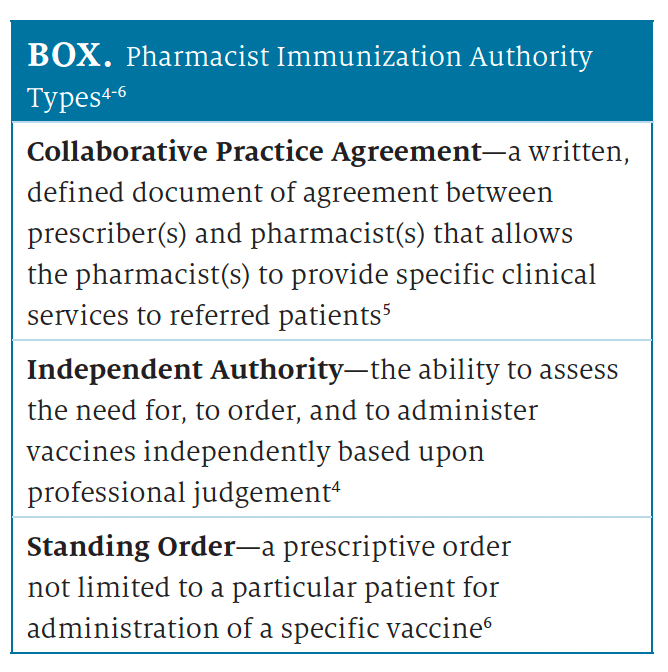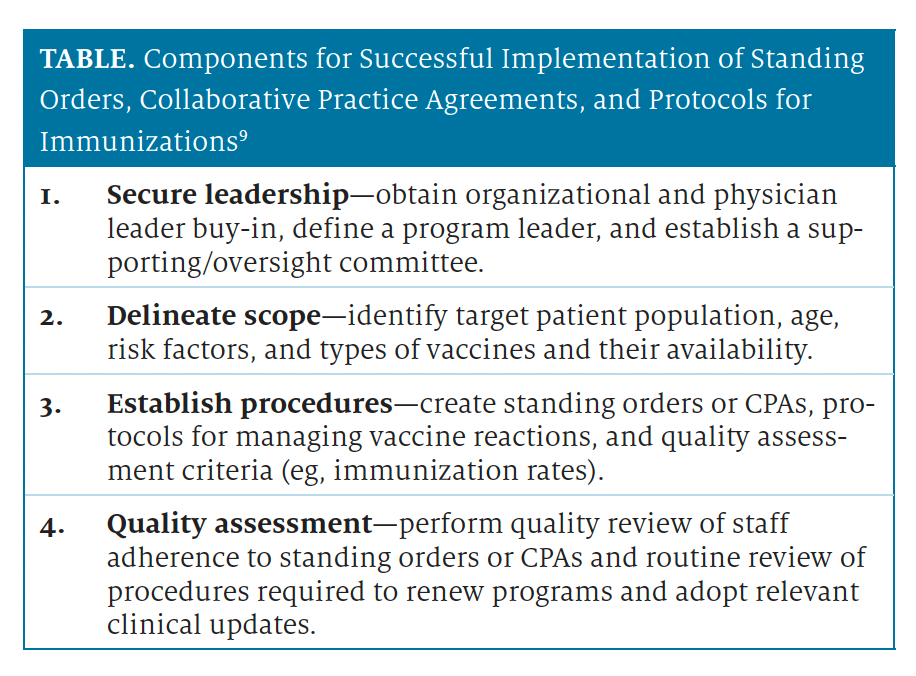News
Article
Supplements
Developing and Implementing Immunization Standing Orders and Protocols
Author(s):
Vaccine administration provides benefits at the patient and public health levels, and pharmacists are critical members of health care teams that provide these vital biologic medications.
Throughout the COVID-19 pandemic, substantial misinformation was circulated about vaccinations and their safety and effectiveness.1 For many years, pharmacists have been identified as trusted health care providers who are readily accessible to support lifesaving vaccination efforts and provide education for the public. The results of 2 systematic reviews and meta-analyses, published in 2016 and in 2022, demonstrated substantial increases in vaccine uptake when a pharmacist was involved in immunization efforts.2,3
Inna Dodor - stock.adobe.com

Pharmacists can administer vaccines in a variety of settings, such as community pharmacies, physician offices, inpatient hospital settings, and stand-alone vaccine clinics. The operational logistics of supporting a vaccination program are part of the pharmacist skill set, with patient safety and efficiency being key elements in the program development process. Critical tools developed to ensure the safety of vaccination programs are written protocols, policies, and procedures. These guidance documents support infrastructure for welltrained team members to establish best practices and to complete documentation and reporting requirements. This article describes types of immunization authority for pharmacists, outlines successful development and implementation of standing orders, and discusses the role of electronic health records (EHRs) in promoting patient adherence to and providing maintenance of vaccination schedules.
Immunization Authority for Pharmacists
The ability of pharmacists to administer immunizations varies according to state regulations and professional boards. Immunization authority can be classified as a statewide protocol or standing order, a collaborative practice agreement (CPA), or an independent authority.4 Regulations for authority are granted on a statewide level or through individual collaboration between an authorized prescriber and pharmacist (Box).4-6
Image From the September 2023 Issue of Immunization Guide for Pharamcists

Standing Orders, Collaborative Practice Agreements, and Protocols for Immunization
Standing orders provide pharmacists with the authority to administer vaccines without separate individual physician orders, whereas collaborative practice agreements provide pharmacists with the authority to administer vaccines in collaboration with physicians or physician groups; protocols for immunizing are comprehensive guidelines that govern the immunization process under a standing order or collaborative practice agreement. Multiple organizations, including the Advisory Committee on Immunization Practices (ACIP), recommend use of standing orders to improve vaccination rates.7 The benefits of standing orders include the ability to define a standard response in various settings, establish safe practices, and provide services to a greater number of patients. Standing orders allow determination of patient eligibility for vaccinations without a prescribing medical professional needing to be present at the time of assessment.8 Developing standing orders and protocols for immunizations requires multiple components for successful implementation (Table)9:
Image From the September 2023 Issue of Immunization Guide for Pharamcists

When developing standing orders, securing the support of leadership—which may include the medical director or chief physician, clinicians, pharmacists, and nurse leaders—is essential.9 Leadership buy-in is imperative for writing standing orders and obtaining the necessary authorization to approve the drafted protocol. To keep the standing order or CPAs up to the latest clinical standards, a regular reassessment timeline should be outlined as part of the initial design. A program lead and committee should be identified to create any implementation protocols (ie, the written processes for the immunization program).
Whereas CPAs allow for customization of the specific aspects to be included based on the agreement between the physician and pharmacist and are customized within that relationship, standing orders have standard components that should be included when they are written. Within a standing order, the vaccinations to be provided should be targeted based upon assessment of the population’s needs.7,8 Additional considerations include the availability of a supply of vaccine from manufacturers, storage and stability capacity, and administration schedules for the vaccine series.8,9 Eligibility criteria (eg, age, individual risk factors, indications, contraindications) for each vaccine product should be defined. Individual state laws may restrict administration of particular vaccines and the age of eligible patients. Clinical screening questions should be established for each vaccine in the standing order and reviewed with patients prior to vaccine administration to ensure that they are eligible and that the vaccine is appropriate based on their clinical status.7,9
To minimize the potential for error, specific administration factors (eg, needle size, administration site, stability timeline, reconstitution directions) should be considered.8 A procedure should be established for reporting any adverse events (AEs), mitigating any administration errors, and preventing future errors. As health care providers, pharmacists are mandated to report any AEs to appropriate health authorities.
It is important to monitor for AEs and establish emergency procedures if anaphylaxis or any other medical emergencies occur.6,7 Management of AEs may include specific parameters, such as administering epinephrine, providing cardiopulmonary resuscitation (CPR), and contacting emergency services.
A standing order should also outline the planned procedures for documentation and reporting on the administration of each vaccine. There may be variable reporting requirements, including the distribution of patient education with the vaccine.
The legal authority to administer vaccines is granted at the state level through pharmacy practice acts. Completion of an accredited program, maintenance of CPR training, and registration with the state board are requirements; however, it is best to further ensure that pharmacists achieve comprehensive proficiency in vaccination standards before a standing order is implemented. This additional training should be a combination of written and hands-on application (ie, demonstration of vaccine administration). A process should be in place for team member remediation and ongoing quality assurance for staff members carrying out the standing order. Continued training should be considered to support frequent changes in vaccine schedules and procedure modifications.
Use of the EHR
Support of the EHR is important for the successful implementation of a standing order, as it can offer decision support for ordering the correct product based upon vaccination guidelines. Proper screening and documentation are cornerstones for a successful immunization protocol, and EHRs can help facilitate completion. Immunization schedules can be integrated into the EHR, which can trigger alert notifications to the health care provider when patients may be eligible to receive specific immunizations. Screening tools and questionnaires can identify possible contraindications or precautions for vaccine administration. The introduction of automation and barcode scanning adds an additional level of safety to the vaccination procedure.
The benefits of using EHRs include both support of health care provider efforts and improvement of the patient experience. Rapid documentation methods (eg, defining the lot number, expiration date, or documentation templates) help to streamline the functioning of immunization clinics. Interoperability is promoted through automatic reporting to state registries using standard vaccine codes (CVX) and manufacturer codes. In addition to transmitting information to state registries, EHRs may also gather outside immunization records from other health care facilities or health information exchanges. EHR portals can also provide vaccine history to patients for their access and review at any time. The billing process is also streamlined based on the CVX code and the proper associated diagnosis code.
Despite their many benefits in facilitating and tracking immunizations, maintenance of EHRs still present challenges. Duplicate patient profiles may be included in state registries, and these may require manual review and reconciliation of information to complete a vaccination history. If duplicate profiles exist, information may not readily flow from the state registry into the EHR. Creation of new patient profiles can result in extensive and sometimes time-intensive data entry requirements prior to vaccine administration. Vaccine schedule integration is beneficial for identifying eligible patients, yet frequent changes in vaccine schedules require modifications of EHR system modifications. Any adjustments to the EHR procedures or general workflow should be supported with training to provide a smooth transition.
Conclusions
Vaccine administration provides benefits at the patient and public health levels, and pharmacists are critical members of health care teams that provide these vital biologic medications. As readily accessible health care providers, pharmacists can meaningfully impact vaccination rates. Development of immunization standing orders and protocols helps to define the scope and streamline the effort. Taking the steps necessary for successful implementation of standing orders, continually evaluating the standing order and protocols, and providing pharmacist competency training ensures high quality immunization care by pharmacists to patients.
About the Authors
Alfred Adam L'Altrelli, PharmD, CFMC, MBA, is the senior director of pharmacy at UPMC Presbyterian-Shadyside, an adjunct professor at the University of Pittsburgh School of Pharmacy, and program director for Health System Pharmacy and Leadership Residencies and Fellowships at UPMC and the University of Pittsburgh School of Pharmacy, all in Pennsylvania.
Trisha A. Miller, PharmD, MPh, BCACP, is a supervisor of pharmacy ambulatory services in the Department of Pharmacy at UPMC Presbyterian- Shadyside and adjunct faculty at the University of Pittsburgh School of Pharmacy in Pennsylvania.
Rebecca Medva, MHMS, BS, CPhT, is a senior manager in information technology at UPMC Corporate Services in Jeannette, Pennsylvania.
Rachel V. Marini, PharmD, BCIDP, is a clinical infectious diseases pharmacist at UPMC Presbyterian-Shadyside and a clinical assistant professor of medicine and program director for Pharmacy Infectious Diseases Fellowship Program at the University of Pittsburgh School of Pharmacy, all in Pennsylvania.
References
- Garett R, Young SD. Online misinformation and vaccine hesitancy. Transl Behav Med. 2021;11(12):2194-2199. doi:10.1093/tbm/ibab128
- Le LM, Veettil SK, Donaldson D, et al. The impact of pharmacist involvement on immunization uptake and other outcomes: an updated systematic review and meta-analysis. J Am Pharm Assoc (2003). 2022;62(5):1499-1513.e16. doi:10.1016/j.japh.2022.06.008
- Isenor JE, Edwards NT, Alia TA, et al. Impact of pharmacists as immunizers on vaccination rates: a systematic review and meta-analysis. Vaccine. 2016;34(47):5708-5723. doi:10.1016/j.vaccine.2016.08.085
- Are A, Hauser R, Spencer R, Satterfield J, Nguyen E. States’ pharmacist immunization authority and the impact on adult influenza vaccination rates. J Am Pharm Assoc (2003). 2022;62(5):1666-1670. doi:10.1016/j.japh.2022.04.017
- Collaborative practice agreements and pharmacists’ patient care services: a resource for pharmacists: a resource for pharmacists. CDC. October 2013. Accessed July 17, 2023. https://www.cdc.gov/dhdsp/pubs/docs/Translational_Tools_Pharmacists.pdf
- Chapter 6: creating standing orders and protocols. In: Angelo LB. Immunization Handbook for Pharmacists. 5th ed. American Pharmacists Association; 2021. APhA Pharmacy Library. Published online June 22, 2021. Accessed August 2, 2023. https://pharmacylibrary.com/doi/10.21019/9781582123653.ch6
- McKibben LJ, Stange PV, Sneller VP, Strikas RA, Rodewald LE; Advisory Committee on Immunization Practices. Use of standing orders programs to increase adult vaccination rates. MMWR Recomm Rep. 2000;49(RR-1):15-16.
- Using standing orders for administering vaccines: what you should know. Immunize.org. May 29, 2023. Accessed June 9, 2023. https://www.immunize.org/catg.d/p3066.pdf
- Steps to implementing standing orders for immunization in your practice. Immunize.org. June 12, 2023. Accessed August 2, 2023. https://www.immunize.org/catg.d/p3067.pdf

Newsletter
Stay informed on drug updates, treatment guidelines, and pharmacy practice trends—subscribe to Pharmacy Times for weekly clinical insights.





